‘The Wake,’ written by Scott Snyder and illustrated by Sean Murphy, is a must-read for fans of horror, adventure, science fiction, and clearly outstanding graphics. Vertigo, a DC imprint, has put its faith in Scott Snyder, which is understandable.
His work on the Batman series has amazed both old and new fans, garnering him accolades and industry respect. He has written horror, noir, and superhero books, as well as books that blend all three genres. He is best known for his work on American Vampire, Detective Comics, Batman, Wytches, Swamp Thing, and Justice League in comic books, as well as his 2006 short story collection Voodoo Heart.
The Wake is a sci-fi horror mini-series that spans ten issues. While many sci-fi comics focus on space exploration and the discovery of new worlds and stars, Snyder’s universe is built around the ocean.
He creates a detailed three-time period timeline for this series, including a past for his creatures and how they evolved, a middle period that appears to be the present, in which he shows how the mere creatures go on to take over the world as we know it, and a terrifying dystopian future that could very well become a reality.
Long Way Down
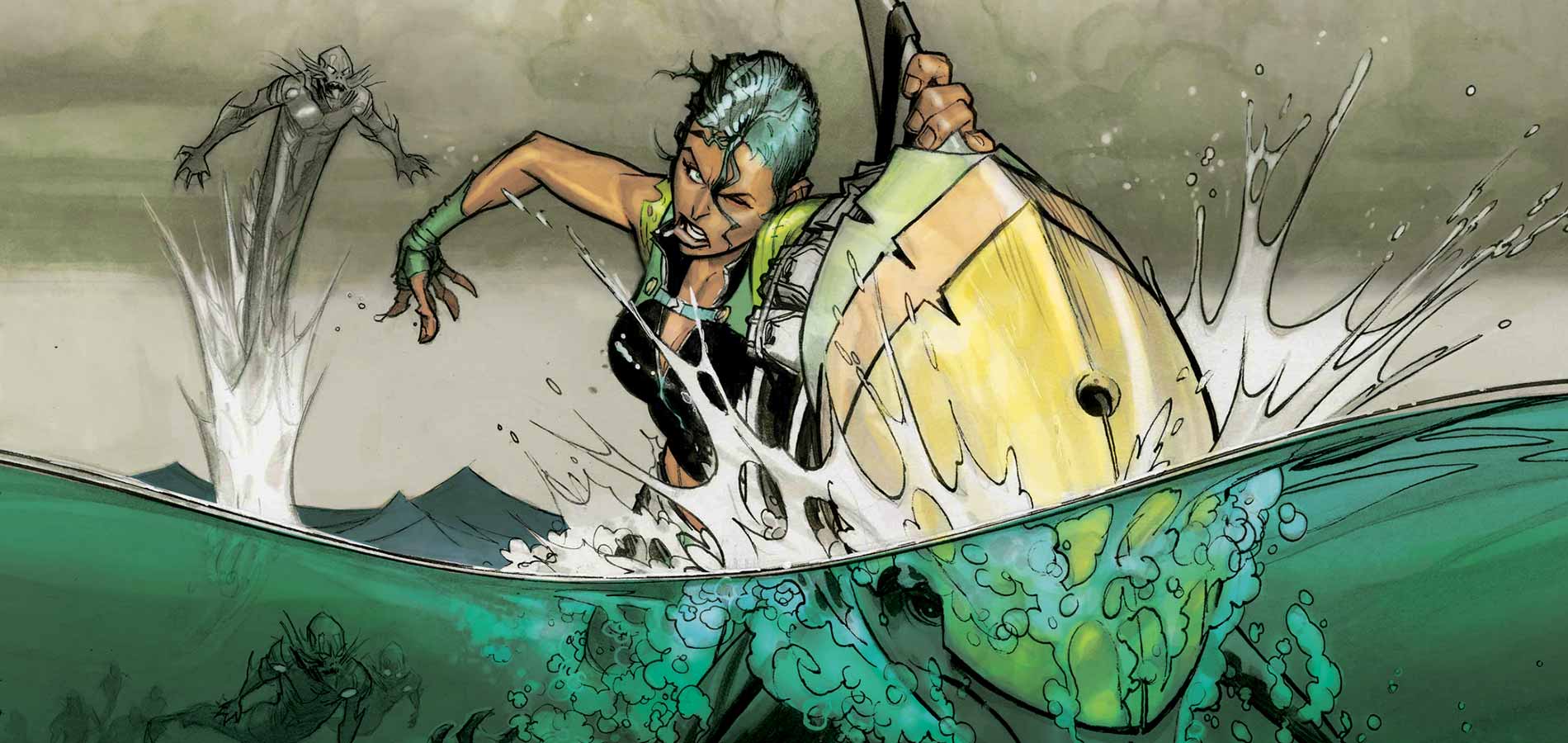
The Wake #1 is the first chapter of a sci-fi/deep-sea adventure that alliterates with the recent Animal Planet faux documentaries on mermaids (Mermaids: The Body Found and Mermaids: The New Evidence, which hundreds—hopefully not millions—believe to be factual documentaries) and incorporates the kind of eerie horror that comes from intelligent fiction about real-life mysteries of the deep.
The story revolves around Dr. Lee Archer, a Cetological Vocalization Specialist recruited by a shadowy Department of Homeland Security agent to join a team of other specialists to investigate a strange new sound heard from the deep ocean. The “The Wake’s” cast is fascinating. Each character appears to have lived a whole life, providing a rich history and distinct viewpoint to the group dynamic.
They meet aboard a submarine, assuming that their specialized knowledge is required to solve a mysterious puzzle. Agent Cruz, the guy behind the curtain who has been pulling everyone’s strings; Dr. Marin, a folklore and mythology professor; Meeks, a brash biologist; Bob Wainwright, and his ex-employee, Lee Archer, make up the squad.
Lee, like Bob, is a marine biologist, and the two appear to have a long history together. Lee is a likable and dynamic female character, another achievement for “The Wake.” She seems to be intelligent, focused, and practical.
Snyder is known for his mastery of characterization and connection development, and he has gone ahead and proven it to us by the characterization of Lee. Lee’s past is seamlessly integrated into the novel, and her purpose for following Agent Cruz to the Arctic is crystal evident. Her relationships with people around her are also insightful. We are always shown, never told, who Lee is as we discover more about him.
The cast members’ portraits by Murphy are articulate and expressive. His figures have a distinct aesthetic touch with little shadows and wide-open color fields. The emotions that the characters go through are eloquently depicted in his artwork. His character work is as outstanding as Snyder’s, being expressive, passionate, and always appealing.
Snyder has carefully crafted a captivating collection of plot lines that will intertwine and clash in future issues. Archer, for example, has arranged for her distant son to pay her a visit on the high seas soon. With the scenario’s explosive potential, expect a touch of domestic melodrama when an inaccessible parent finally comes to her child’s aid as he is pursued by the beast from the frigid lagoon.
Amidst all this, she rapidly finds there’s a lot more to this unusual, organic-sounding oceanic sound. Snyder adds historical context to his main tale by enigmatic scripting events 200 years after and 100,000 years before the main events in the prologue and postscript chapters.
The Wake’s first issue is more of an intricate promise than a finished product, which is great because only a few long-form stories can prove their worth in just 25 pages.
Mythology to Evolution

“The Wake” #2 takes mythology and evolution and flips them on their heads to create the foundation for a compelling horror story that spans millions of years. In this must-read series, Snyder’s skill for bringing a scary horror slant to even very intellectual stories and Murphy’s ability to depict anything imaginable come together beautifully.
Snyder’s story jumps back and forth in time, from 5.1 million years ago to show us a “2001: A Space Odyssey”-style version of early man (dark, fascinating, and tied directly to the larger narrative), to the “200 years ago” heroine attempting to solve a mystery deep within the underwater station, to the present day — a world engulfed by water. When we return to the book’s present tense (that feels like/is the future) at the end of this issue, I admit I almost lost where we had started in the first issue.
We return to the present with Lee Archer and the team as they get a good look at the weird creature grabbed by the oil rig workers after a flashback to ancient times. The team then spends the rest of the issue debating and speculating about what the sea creature is and disclosing additional information about the individuals. The way this issue ends, on the other hand, shows something quite dangerous about the beast’s talents.
Unlike the last one, this one is slow-paced and contains little action, at least until the finish. It’s more about concocting theories and concocting notions about the monster. It’s all excellent, and most of the concepts are intriguing, but it’s a welcome change of pace after the first issue’s brevity and the fact that the plot doesn’t really develop.
It’s a bold and aggressive piece that asks a lot of its audience, which isn’t necessarily a bad thing. It reminds us how nuanced and complex the story actually is. The communication between the characters is natural and flowing. The notions and concepts discussed above are fascinating.
The characters, especially the main character, are charming and make you want to learn more about their backstories. The plodding pace is broken up by the last couple of pages, which is creepy and unsettling. However, the comic might be a little wordy at times. Regardless, the writing is still quite good.
It’s not simple to write or read a book that spans many time periods and perspectives while hopping around regularly, but Snyder and Murphy do it flawlessly here. The Wake #2 takes all that was great about the first season of the mini-series and grounds it in a high concept and an increasingly rich experience. There’s no doubt in my mind that this book is destined to become a true classic.
Snyder manages to strike a balance between stylistic clues and actual revelation and plot progression, leaving the reader feeling confident in themselves, thinking that they know where the tale has gone, even if the next step is a jumble of disconnected dots and questions. The mystery discovery’s supposed history is intriguing, to say the least, but there’s still a lot of room for speculation.
What does it want to achieve? Are these hallucinations merely coincidental, or are we witnessing the emergence of a siren from the depths of our past? What does all of this have to do with that strange girl from the future? The strange men-glare, people who look like a cross between a chimp and a shark, is persistently homicidal, causing me to wonder how terrible this new, so yet confined threat can become.
Murphy continues to create a legitimately scary portrayal of both creatures and humans, pitting Archer’s colleagues against deep-sea monsters for the most horrific outward traits. Murphy’s ability to capture tension compares favorably to horror classics like the original Alien, making for an exciting and scary read. This, along with Snyder’s deft symbolic work, creates a really satisfying read.
Under the Water
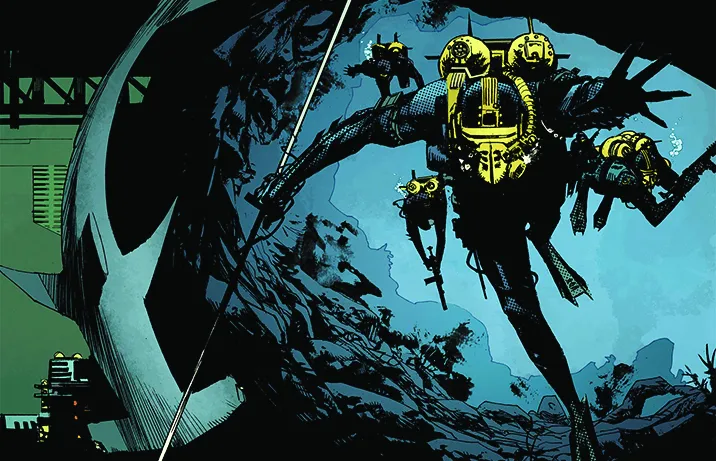
Making comics is a never-ending battle of trying to come up with the most effective opening pages that will grab the reader’s attention and instantly engross them in the tale the comic is trying to tell.
Scott Snyder and Sean Murphy may have discovered the most effective introduction to a comic in a long time with “The Wake” #3: portraying Mars as an Earth-like planet and then showing something colliding with it in a catastrophic, potentially planet-destroying explosion. That’s how you start a comic. And, happily, because we’re talking about Snyder and Murphy, those two opening pages don’t overpower the rest of the comic.
Our protagonist, Dr. Lee Archer, and her colleagues find themselves in deep water in the third issue of Scott Snyder and Sean Murphy’s The Wake. The underwater rig is on high alert after its hostage, the killer mermaid (believe me, it’s a lot scarier than it sounds), broke away from its confines in the last issue.
In a comic book, being trapped in a massive rig at the bottom of the sea with an unnatural creature may be the closest we’ll get to the profound claustrophobia of films like Alien. Murphy’s art, as superb as ever, is partly responsible for the claustrophobia.
The rig’s structure, with tiny, narrow halls and massive bulkhead doors that always appear to lock unknowing victims in the beast, captures the impression of industrial claustrophobia. Not only that, but he also shows the rig gradually filling up with water on each panel, which is difficult to achieve with still panels.
Given how skilfully Snyder and Murphy have cranked up the tension and dread, it’s hard to think we’re only a third of the way through the series. The Wake’s universe is tightly structured and claustrophobic, but it doesn’t make it any less of a showcase for enormous world-building.
Even the splash page with the team rushing to flee the rig depicts the magnitude and vastness of the surroundings compared to the characters the story follows, thanks to the excellent use of negative space. Like in the previous issue, Snyder relies mainly on verbal information dumps to fill up the gaps in the story. This method would slow down the story in the hands of a weaker writer, but Lee’s monologue is set over a series of action-packed panels that keep the plot moving forward at a rapid pace.
Survival of the fittest
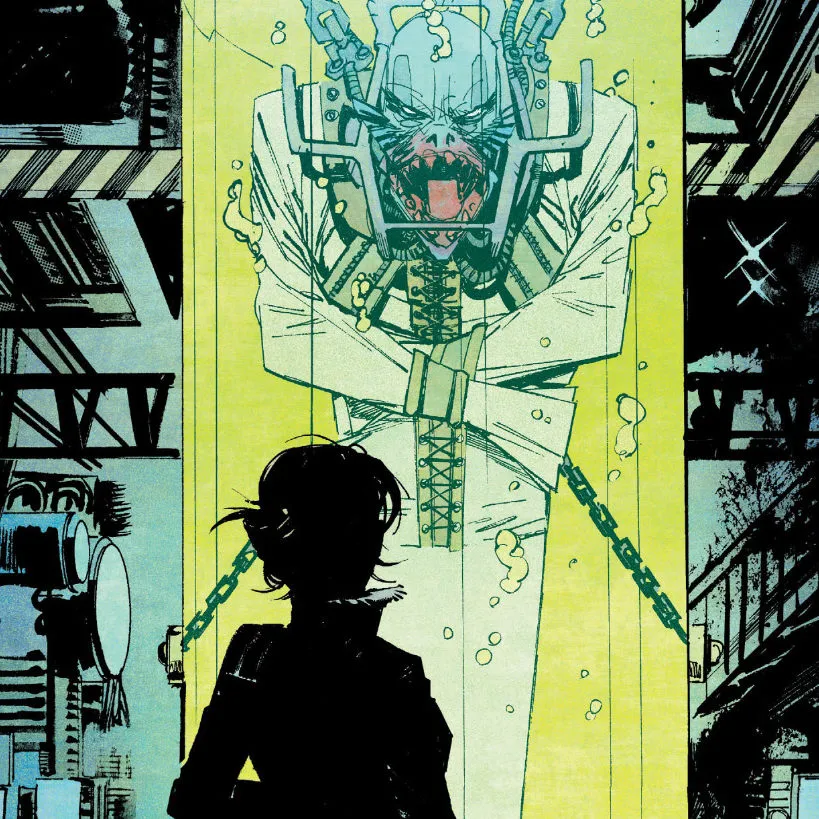
In each issue, Snyder has been developing mythology over multiple periods, interlacing pieces from a larger story within the structure of his primary storyline. While The Wake is the type of novel that frequently leaves you with more questions than answers, it’s somehow not as annoying as it could be as a storytelling strategy.
The prologue of the comic takes place 100,000 years ago, when two tribes engage in a horrific and deadly battle, one of which is armed with strangely modern technology. This out-of-date prologue alluded to the mythology of epic proportions. The main narrative thread might not stick out as much if it didn’t have it.
Our ultra-secret crew of scientists and mercenaries have been besieged by the dangerous mer-creatures they unearthed deep beneath the ocean surface in The Wake #4. Will our gang of characters be able to discover a way out in time, with time running out and nowhere to go? The Wake certainly creates an environment of intrigue, with each page increasingly turning into survival horror from the deep ocean mystery that we had thought it to be.
The Wake begins to feel a little too traditional as Dr. Lee Archer and her colleagues flee to save their lives. The man-eating mermaids are still on the loose, ripping apart machinery and flesh with equal ferocity. There’s even a scene where the crew’s attempts to find safety are thwarted by a stubborn keypad and a lost code; the question of whether they’ll be able to override it in time (or become fish food) is a tired trope.
Murphy’s atmospheric imagery, on the other hand, is adequate to make up for the book’s flaws. The tiny facilities and limited quarters of the rig heighten the stress to nearly physical levels.
While the fourth issue isn’t the best we’ve seen so far in the series, it’s definitely a good step forward. Making one particularly curious as to why cannons were used in the distant past.
Mythology is just history repeating in stories
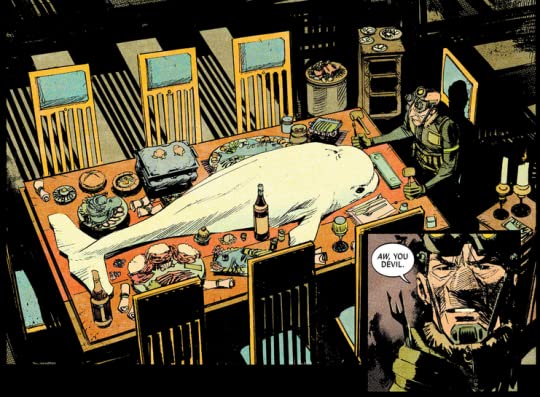
This ocean horror story is distinctly divided into two parts. The first part comes to an end in this issue of The Wake. This book is divided into two distinct sections at this point. By the end of issue 5 of The Wake, you won’t be wondering how the folks confined in the underwater station could possibly keep going for another five issues. Things come to a final conclusion in this issue. Scott Snyder is known for spinning surprisingly complex stories, and The Wake appears to be no exception.
This story seemed to be rather basic at first, a survival-horror-styled story featuring the secrets of the sea. It’s evident now that it’s much bigger than that. Although the history lecture appears to be finished, this isn’t your typical first-year survey course on humans. This installment of Scott Snyder’s ten-part underwater adventure continues to blend three time periods and as much action as the story allows.
With their brilliant mini-series “The Wake,” Scott Snyder and Sean Murphy have discovered a way to delve into our most primitive anxieties, concluding their first arc with a gloriously horrifying finale — yet not without a splash of optimism. The adventure of the sea crew resumes up just where it left off in the previous issue: besieged by terrible, hideous creatures.
After the deadly monsters attack their rig, a whale-sized counterpart of the mermaids emerges from the depths. The crew learns that the attack on them was really a practice run, a reconnaissance operation and that the actual target is the mainland coastal cities.
These animals have been tied to big flood legends throughout human history, and they have now returned to raise the waters once more. The crew boards a deep-sea hunting submarine to make one last stand against the monster mermaids while trying to warn the rest of the planet of the impending tragedy.
If a reader’s capacity to get more out of a tale with subsequent passes is a testimonial to the writers’ competence, Snyder and Murphy deserve a lot of credit for this issue. The plot takes a multi-layered approach. For example, in addition to looking absolutely stunning, Murphy’s opening depiction of the ocean reflecting the night sky adds nuance to the comic as a whole, implying that we know as little about the sea as we do about the universe — and, with Lee’s extended hand, that we’re just caught in the middle.
Their emotionally intense moments are handled with equal finesse; the build-up around Lee’s refusal to cry ends in a gorgeous panel that accentuates her tear-filled eyes, and the entire page exudes her utter horror. Such sequences are expertly placed throughout the novel, never becoming obtrusive or detracting from the plot. It’s easy to get lost in this novel, again and again, thanks to Snyder and Murphy’s subtle ideas.
Is Back to the future

The world has changed 200 years after the events of Part One, thanks to the fish monsters melting the polar icecaps. The lowest landmasses have been submerged, and humanity is surviving in makeshift scavenger camps. We’ve seen snippets of this futuristic/post-apocalyptic world previously, but now the developers get to present it to us in its entirety. This universe is seen through the eyes of Leeward, our new protagonist. Leeward is the protagonist, along with her glider and her trusty dolphin Dash; she’s a fish monster head hunter (literally).
The sixth issue of “The Wake” takes place two centuries in the future, when humanity faces extinction at the hands of the Mers. The creatures have multiplied and become more assertive since first appearing to the fateful band of scientists. The ice caps melted as a result of their manipulation of ocean currents.
The Mers assaulted humanity as the water rose and poured inland, bringing civilization to the brink of anarchy. Leeward, the previously unknown heroine, survives by scavenging until she incurs the anger of a local boss-type. Her world appears dark and terrible until a voice from the past comes, offering her a chance to combat the Mers.
Leeward enters the center stage of “The Wake” after being shown in brief flashforwards. Instead of filling up the lovely artwork with more words, Snyder takes the correct option to let her actions tell the viewer about her character traits. Leeward’s journey across the flooded metropolis demonstrates her wit, tenacity, and bravery. Leeward makes excellent sense in this universe, and she blends in flawlessly with the surroundings.
The supporting cast is introduced throughout this issue, and they are all appropriately gritty. They are survivors; the world is cruel, and they have grown cold enough to get through each day. We are introduced to several new threats, and while the “Mers” is undoubtedly one of them, Snyder shows us that humanity may be just as dangerous to itself.
The Governess, the primary antagonist, acts more like a Mafia Don than an elected politician. It’s yet another example of Snyder’s ability to use his characters to make more comprehensive statements about the culture in which they live. The Governess appears to be trustworthy and safe on the surface, yet she is just as vicious and dangerous as the rest of the world.
As the tale requires, the palette varies quickly, moving from delicate, washed-out panels to pages that feel saturated and dark. It’s a stunning mix with a lot of pop and a strong focus on some essential aspects, such as the water, which is breath-taking in its clear blue. Leeward is an unusual color, slightly orange and darker in tone than many other characters, implying her active hunting life on and in the sea. Most comics should have these kinds of well-considered colors.
Curiosity killed the cat
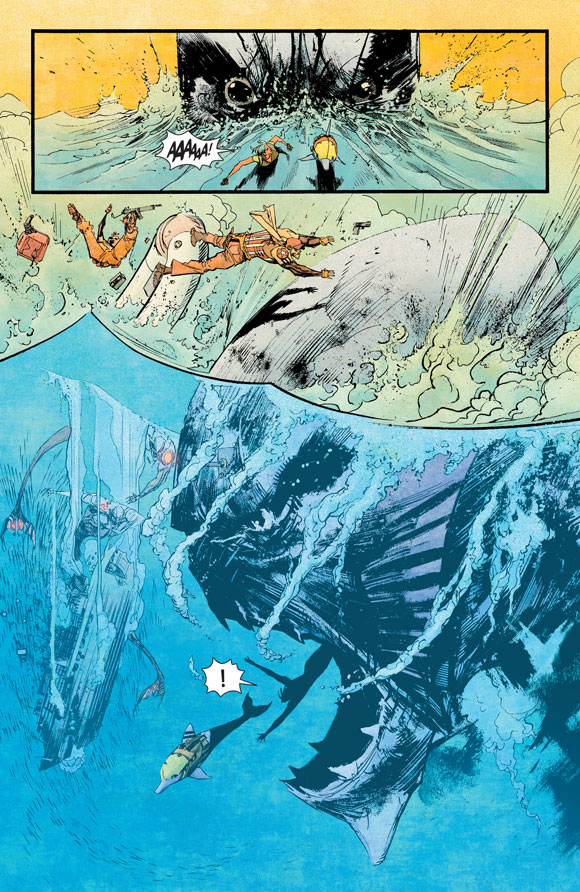
In the 7th issue of The Wake, we learn that creating something as epic as a creation myth without sacrificing the wonder of every day is not feasible. Compared to the creatures that inhabit her world, Leeward’s battle is practically mundane. Still, it’s that Everyman quality to her thoughts and deeds that makes her unmistakably human in a world where her species is on the edge of extinction from both internal and external threats.
Leeward’s travels are constantly hazy and difficult to follow. She stumbles from one bizarre event to the next – she turns on a radio and is pursued by the authorities of this world because radios are dangerous in this new dystopian world. The government has kidnapped Leeward and her friend Pub (who is said to have raised her) and forced them to board one of their ships.
Along with the weird signal she picked up the last time, they have a deadly plan for her. We are faced with her perseverance and heroic defiance when she refuses to submit to the capital punishment of the new world.
It also delves into Leeward’s past and elucidates a few more details regarding the new world, which leave you wanting more with each new word. Just before all hope seems to be lost for Leeward, Snyder pulls up another twist with a mysterious ship.
Murphy’s art and Snyder’s writing are so inextricably linked that it’s challenging to envision The Wake without one of them at the helm. The atmosphere established by the book’s images lends itself to the iconic sense while also contrasting it with Leeward’s grittier reality.
Compared to her, the ship-sized Mer that attacks the ship that she is on is nearly godlike, and the full-page splash that conveys its anger is a masterclass in utilizing color, shadow, and shape to evoke a sense of awe.
Even though this issue is a little short, Sean Murphy’s artwork is outstanding as always. The one-of-a-kind designs are eye-catching and genuinely evoke a sense of discovery (I especially like how the ships look in the issue). The action is terrific, and the layouts are fantastic, especially some of the impressive full or double-page spreads that give you a tremendous sense of the situation throughout the action scenes.
The search for truth
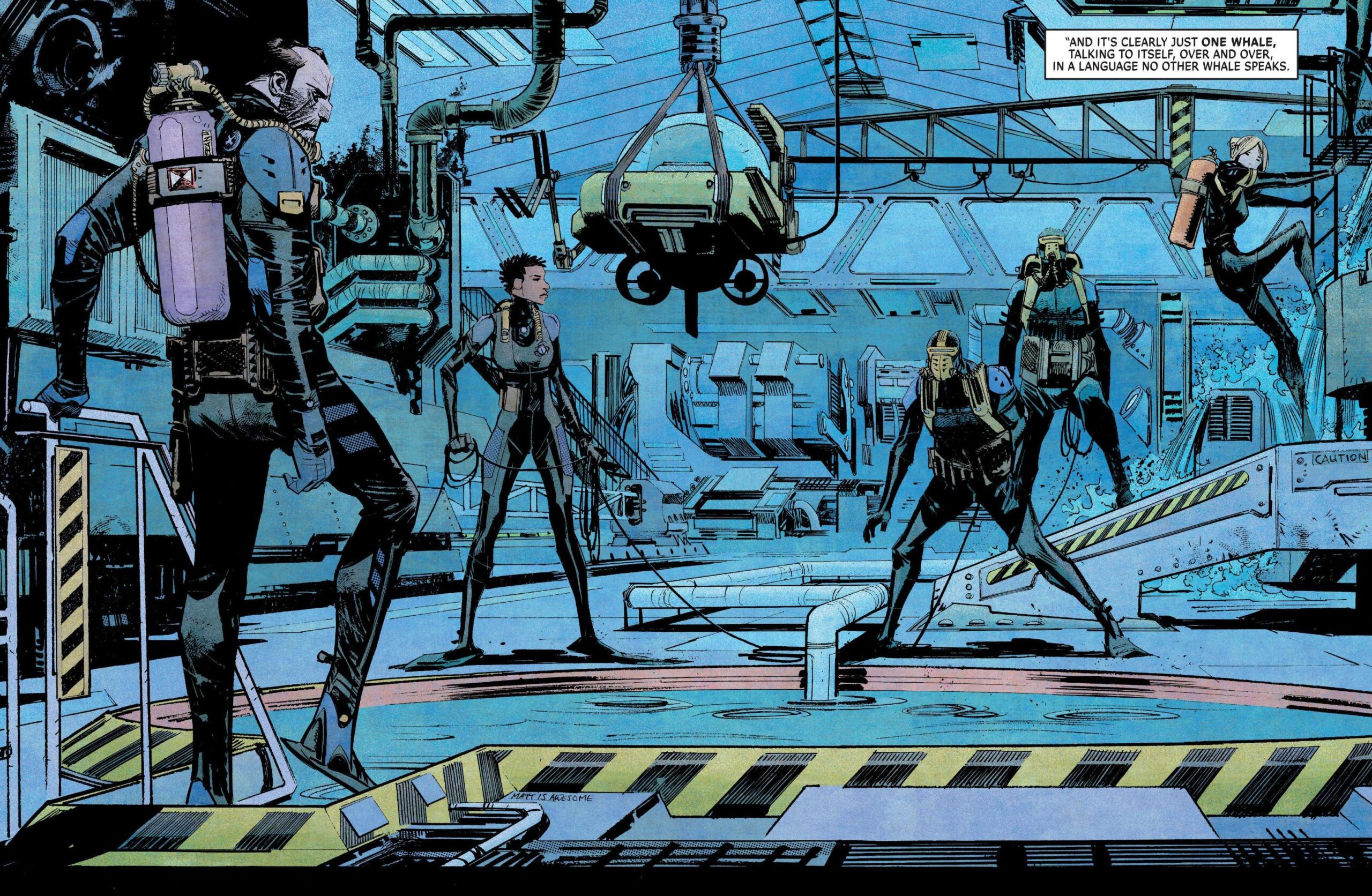
“The Wake” continues its fantastic run with the 8th issue, which considerably raises the stakes both emotionally and plot-wise. There are many mysteries, but Snyder promises solutions as he explores deeper into this fascinating realm. Snyder throws a good curveball with this issue by having his outliers deny Leeward’s signal until they hear Lee Archer’s name. Though much of this issue is dedicated to defining the outliers’ world and Captain Mary as a character (which is excellent work), Leeward is the true core of the issue.
By the end, she’s shown that she’s willing to devote her life to this cause as long as they find the signal and figure out what it means. Her life is a modest price to pay to rescue the Earth. Fortunately for all of us, she won’t have to pay that price, and we’ve set the stage for the hunt for the signal, with Governess Vivienne and her entourage following closely after.
Scott Snyder has demonstrated that there is always more beneath the surface than we are aware of. While the Mers make this a physical actuality for our protagonist, Snyder proves it to his readers with each new twist and revelation. The Mers have been presented as vicious creatures since the story’s beginning. While nothing in the issue explicitly indicates otherwise, Snyder begins to imply that something else is going on as well.
As more is revealed and some deadly action occurs, readers aren’t given much time to think about what that might be. This adds a great lot of tension to the issue. The result is an interesting new direction for our characters that readers will want to see more of, even if some of the action is a little tough to follow at times.
A couple of layouts aren’t as apparent as they could be, probably because Murphy is stretching storytelling boundaries (which is a good thing). When their house is bombed, it appears that Leeward is abandoned by the outliers and left tied up on the surface, only for them to come back for her and discover her somewhere else wholly intact. What happens is mainly clear because of Snyder’s writing, but it’s absolutely confusing from a storytelling standpoint.
No quest returned
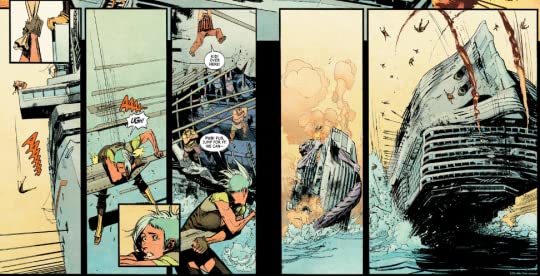
Any hopes of things slowing down and allowing tension to develop for the finale are dashed after just a few pages in the penultimate chapter of the series.
The first issue of The Wake opens with Leeward, now the intriguing Captain Mary’s first mate, keeping a “captain’s” log similar to that of her enigmatic predecessor Lee Archer. After persuading Mary that a radio signal from the twenty-first century could be the key to saving the world from the vicious race of Mer creatures, the ship and its crew set out to investigate the mysterious transmission. From this point on, Snyder and Murphy begin to chip away at any hope that may have been built up during this arduous journey.
While methodically developing this epic tale, Scott Snyder maintains a fast pace. There’s so much to take in that the story’s scale threatens to eclipse the individual characters; yet, Snyder masterfully weaves in plenty of character development details along the way, so this isn’t a problem.
In fact, one of the story’s many strengths is its colorfully diverse and fully realized cast; there’s Leeward, the plucky idealist, Captain Mary, who provides a dose of fun when things threaten to become oppressively heavy or bleak, and then there’s the sinister Governess lurking in the shadows, waiting for the right moment to strike.
These are traditional tropes that Snyder has subtly altered to serve as conduits for his intricate and profoundly human story. This issue is rich with subtext, mystery, and suspense; as we approach the last chapter, the story’s tone appears to have darkened, even more, our heroes’ circumstances have become increasingly dangerous, and hope is becoming increasingly elusive.
Leeward and the crew have arrived off the coast of the Horn of Africa after following the signal almost halfway around the world. They’re expecting to find something left behind by the scientists featured in the first part of the series that will aid the survivors in their fight against the Mers; yet, it could just be different false hope or, worse, a trap.
They employ well-placed explosives to trace the signal far underground to blast a hole in some of the only remaining dry areas. When the dust settles, it appears like they discovered a tomb containing pictographs telling a story about the Mers. The Governess, the power-hungry antagonist, arrives with a small army set on wreaking chaos and ruin just as Leeward and the team begin their investigation.
Murphy goes into full action mode when the Governess arrives, and everything goes to hell in a handbasket. The explosions are massive and realistic, yet they don’t come at the expense of character depiction. Murphy’s hard-lined style keeps everything distinct and focused, even as things become more hectic.
There are no hazy shortcuts here. It’s astonishing that, despite all of the bizarre events that have occurred in this series, the sight of the Governess fleet remains a standout moment that looks as grand as any war film. The final visuals of Mer-made whirlpools and ghostly psychedelic encounters feel just as natural as any action scene because Murphy excels at penciling things that are just a little bit odd and fanciful.
The finale of “The Wake” moves at a breakneck pace compared to the first five issues.
The ocean is an adventure waiting to happen
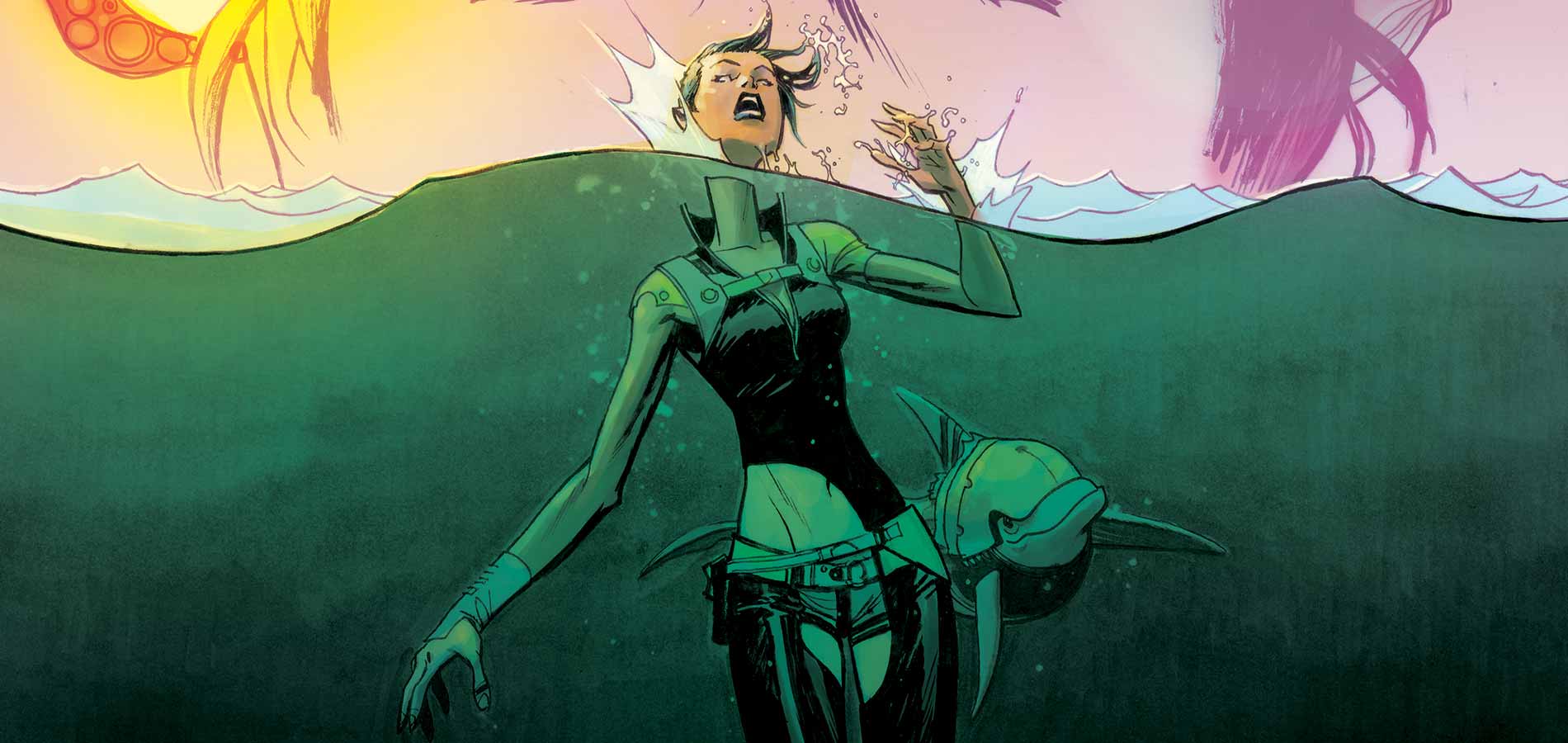
Snyder rewards those who have been paying attention with this finale; the last issue, like the rest of the series, cannot be readily devoured and comprehended by people searching for quick and straightforward amusement.
In reality, anyone who arrived late or missed a problem along the road is likely to be dissatisfied — but they can only blame themselves. One complaint can be leveled towards “The Wake,” it would have been better delivered as a graphic novel rather than a serialized story; Snyder’s storytelling approach places essential parts in unexpected locations or before readers are ready to comprehend their significance.
The first two issues are the perfect horror movie setup; a group of explorers locked together in an underwater oil rig with an unknown entity eager to break free. It’s terrifying and tempting to any horror/sci-fi enthusiast. The sequence where the creature utilizes its strange, hallucinogenic powers to mislead Matthew into believing that his wife is on board and tricking him into releasing it, as well as the hellish watery hell that follows, gives me chills every time.
From there, we jump back and forth in time, from after the Mers flooded the globe- to much before that, all the way to the beginning of human history. The genuinely unusual aspect of this book is that, in just ten issues, Snyder weaves millennia of history and lore into a single plot that culminates in a gripping and dramatic conclusion when we reach the grand finale. This is especially impressive given that the world he creates for most of the novel is almost entirely submerged in water.
In this last, mind-bending issue, two tales unavoidably and eventually converge, bringing this remarkable series to a close. The stories of Dr. Lee Archer and her doomed expedition, as well as a woman from the future named Leeward, who risks everything to uncover the truth with her sonic dolphin sidekick, intertwine to reveal a mystery at the ocean’s depths that neither could have predicted at the outset of their journeys.
Both women are on a mission to locate the answers at the heart of what’s down there, but they wind up discovering a lot more. They find harmony, and one of the most substantial aspects of this mini-series is that it features not one but two female protagonists.
Leeward has the ability to distinguish between what is real and what is not. The government’s lies have come to an end, and she now understands why her encounter with Dr. Archer took place. She also believes what she learned from Dr. Archer: humans are an alien species who have forgotten their own beginnings.
Because they are not seeking to completely exterminate mankind, the Mers is not entirely ruthless towards them as an invasive species. Some humans have been restored to their ship (probably the most clever and caring). This keeps the gang together as they prepare to travel to the next planet on their list.
The government will not listen to Leeward’s explanation of what happened in the underwater cave once she returns to the surface. The president indicates that the entire scenario was a hallucination in between threats of torture. It demonstrates that humanity had purposefully closed their eyes and lapsed into a dream that they had permanently inhabited Earth. Understanding the reality of their position requires them to open their eyes and regain vision.
The spaceship defies the sonic net and rises up from the water, while government officials rejoice over keeping the truth from the people. A ray of hope appears at that moment, and General Marlowe shoots the president in the head. While assassinating a figurehead is never a good way to put an end to a movement, it is an excellent way to get Leeward out of prison, and she runs into the sea with his support.
The Governess is a classic dystopian villain who desires solely personal fame at the expense of the remaining population’s determination. In that regard, she had appeared a little too familiar up until this point in the series, so it was good to see her disclose some unexpected complexity before the story came to a close.
For people and Mers to coexist, the last bastion of human government must be abandoned. Leeward and a Mer stand on the ocean’s surface after the airship is destroyed and the spaceship leaves the planet. Her acceptance of knowledge and co-existence marks the start of a new period, which begins with a kind gesture: she waves to the Mer, who descends quietly.
Daybreak hangs above a beautifully lighted ocean scene with a patchwork sail in the shape of a Mer’s face, the ship named after General Marlow’s slain daughter, and a fresh-faced Leeward directing the ship while Mers and Dash the Dolphin sprint over the waves in The Wake. Leeward’s final words are a battle cry for all of our world’s inhabitants, humans and Mer alike: “Don’t cry! Be brave! It’s all an adventure!”
What began as a light-hearted horror series finishes with the triumph of optimism over oppressive powers. The Mers, despite being the frightening hook that drew many readers to the series, have very little to do with the events of Leeward’s climactic struggle. It’s not horrible, but it’s a significant departure from what most people expected the series to take after the first issue.
Even as massive explosions occur, Snyder’s writing never comes across as self-righteous or preachy, and he manages to sneak in countless minor character moments that give further layers of emotion to the ending.
Even in its own genre, “The Wake” has been about twists and turns from the start. Scott Snyder and Sean Murphy are a fantastic partnership, and they’ve packed so much depth (no pun intended) into this horror narrative that it’s bound to be a success in trade format. The ending is exciting and unexpected, and it appears to follow the series’ goals to the letter.
The Wake is a dystopian sci-fi horror comic that makes you think and uncover the deeper sub-contexts embedded in it. The fear of the unknown as well as the scary reality of the rising oceans not only make you think about what is hidden under those beautiful blues, but it raises a legitimate concern for environmental conservation. The fact that the ocean is a largely unexplored territory in the real world makes the story’s premise just close enough to reality to make it scary.
